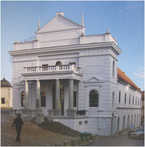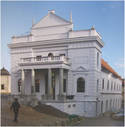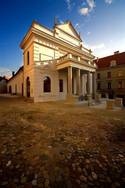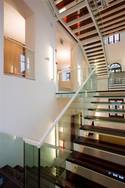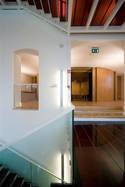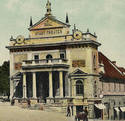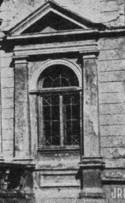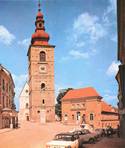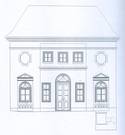Ptuj Town Theatre
alias The District Theatre (? - 1956), Ptuj Town Theatre (since 1956), Union's Theatre (1947 - ?), People's Theatre (1946 - 1947), National Theatre (1945 - 1946), Stadt Theater (1896 - 1945), Städtisches Comödienhaus (1786 - 1896)Slovenski trg 13, SI-2250 Ptuj | |
| show on the map | http://www.mgp.si |
Important events
Between 1938 and 1941 playwright Anton Ingolič invited Fran Žižek to work as a director. In that time the the Ptuj Town Theatre's repertoire was among the most important theatre repertoires in Slovenia.
Nazis removed the entrance portal. Plans for the exterior were created by Tasilo von Müller.
People
History
Ptuj is considered to be one of the oldest towns in Slovenia. The theatre building, which dominates the central road connection between the western and eastern part of the town, appeared in the very centre of the medieval urban design. Until the fire in the mid-18th century, the site next to the parish church was occupied by the provost’s house. It is thought that the construction of a theatre building was in 1786 commissioned by the aristocracy of Ptuj and its surroundings, together with the town inhabitants. In the 18th and 19th centuries performances by German and Italian travelling comedians and theatre groups that first began visiting Ptuj in the early 18th century were staged in the theatre then known as Städtisches Comödienhaus. The oldest preserved flyer that bears witness to the activities of the Ptuj theatre was printed in 1798. In spite of numerous later renovations, the building to this day remains the most beautiful example of a small Baroque town theatre in Slovenia.
The remains of the walls of the provost’s house, that was razed by fire, were most likely incorporated in the construction of the theatre. It was built on a site parallel to the longer side of a rectangle with a slanting truncated north-western corner. The theatre premises were in 1786 built above the older vaulted ground floor. They were divided into a section for the audience and the stage, whilst in the eastern part behind the stage there were the auxiliary rooms. The entire inner construction of the auditorium was made of wood. The stalls in the west finished in a semi-circle and were probably from the very beginning surrounded with boxes on two levels. On the east side, the space for the audience was connected with the equally wide and extensive space for the stage. Whilst the auditorium had a level ceiling, the stage needed to be open up to the roofing so that the scenery could be moved. Initially, there was just one entrance on the eastern side.
In 1829, the theatre was thoroughly renovated for the first time. In 1848, the exterior acquired a Classicist form. In 1854 the interior was modernised and a new access to the boxes and the balcony was added. The stage was equipped with six brand new sets of scenery and an extensive rope and pulley system for the quick changing of sets. Between 1892 and 1896, the theatre was renovated once more. Following the plans by the Viennese architect Rudolf Klotz, the building was given an impressive new main façade and an entrance hall with a combination of neo-Renaissance and Classical elements. The façade was one level higher than the theatre building itself and was further emphasised by a high portico with four columns and a triangular gable. The new façade thus completed the south-eastern corner of the central square in a rather impressive way and ensured that the theatre building became more prominent. The interior was not changed significantly during this renovation.
Until the end of the Habsburg monarchy in late 1918, performances were exclusively in German or Italian, but after that, until the start of the Second World War in Yugoslavia in 1941, in Slovene. The theatre ceased its activities after the German occupation of Yugoslavia in 1941. Directly after the start of the war, the Nazis planned to renovate theatres in Maribor, Celje and Ptuj to give them a new architectural image and with it a completely German character. What they disliked most about the Ptuj theatre was the over-decorated main façade. Between 1941 and 1942, all decorative and sculpture elements were removed, as well as the portico and the high triangular gable. The plans for a much more austere façade with a four-hipped roof were created by the architect Tasilo von Müller. However, memories of the former theatre façade stayed alive among Ptuj inhabitants for a long time after the war. In June 2006 it was thus decided that it should be renovated to resemble the one destroyed in 1941. At the same time, following plans by the Plan B architectural bureau from Maribor, the renovation of the entire building was carried out in 2007. Sadly, the entire internal construction was removed during the building work and replaced with a new minimalist design, which almost completely erased all the former Baroque features.
sources and literature
Fran Alič–Jože Rojic, Gledališka kronika 1912-1952, Ptuj 1952
Arhitekt. Revija za arhitekturo, urbanizem in oblikovanje izdelkov, št. 15, 1954, pp. 26-27
Andreja Babšek, Kratka zgodovina ptujskega gledališča, Dialogi, Letnik 36, št. 3/4, 2000, pp. 59-68
Andreja Babšek, Mejniki v razvoju ptujskega gledališča. 1918-1958, Ptuj 2001 (Zbirka Zgodovina ptujskega gledališča)
Marjeta Ciglenečki, Ptuj na starih vedutah, razstavni katalog Pokrajinskega muzeja Ptui, Ptuj 1983, 1989
Marjeta Ciglenečki, Ptuj. Najlepši pa je zame Ptuj, Maribor 1995, pp. 56, 62, 65
Marjeta Ciglenečki, Nesrečne rekonstrukcije, Umetnostna kronika, 17, 2007, p. 1
Marjeta Ciglenečki, Ptuj. Starodavno mesto ob Dravi, Maribor 2008
Iva in Jože Curk, Ptuj, Ljubljana 1970, pp. 61, 132, 133
Jože Curk, Ptuj in njegovi kulturnozgodovinski spomeniki, Poetovio-Ptuj 69-1969. Zbornik razprav ob tisočdevetstoletnici, Maribor 1969, p. 174
Jože Curk, Mali grad na Ptuju, Ptujski zbornik, 6, 1996, pp. 441-461
Andreja Čelan, Odrske deske na Ptuju (med leti 1958-1994) v luči lokalnega tednika, diplomsko delo na oddelku za Sociologijo Pedagoške fakultete Univerze v Mariboru, Maribor 2003
Slavko Desetak, Gledališka dejavnost v Ptuju, Gledališki list Okrajnega gledališča Ptuj, leto V., sezona 1954/55, pp. 37-46, 71-76, 112-125, 177-183, 217-221, 264-268
Slavko Desetak, Gledališka dejavnost v Ptuju, Gledališki list Okrajnega gledališča Ptuj, leto VI., sezona 1955/56, pp. 16-17, 42-44, 66-73, 92-93, 131-136, 155-180
Slavko Desetak, Gledališko pročelje Mestnega gledališča v Ptuju, Gledališki list Okrajnega gledališča Ptuj, leto VII., sezona 1956/57, št. 1, pp. 12-16
Jože Gregorc, Načrtovana preureditev pročelja gledališke stavbe, Gledališki list Okrajnega gledališča Ptuj, leto V., sezona 1954/55, p. 62
Marlenka Habjanič, Gledališče Ptuj. Slovenski trg 12 in Slovenski trg 13. Konservatorski program, Zavod za varstvo kulturne dediščine Slovenije. Območna enota Maribor, Maribor maj 2005, tipkopis
Marlenka Habjanič, Ptuj-Mestno gledališče, Varstvo spomenikov, XLIII/2007 Poročila, 2007, pp. 180-181
Andrej Hrausky-Jurij Kobe, Atelier Arhitekti, Ljubljana 2007, zloženka Gledališče Ptuj
Irena Mavrič, Ptujsko gledališče 1786-1958, Ptuj 1988 (razstavni katalog, Pokrajinski muzej Ptuj)
Janez Mikuž, Orfejev spomenik Ptuj, Dnevi evropske kulturne dediščine. Kulturne poti 1999.Vodnik po spomenikih, Ljubljana 1999, p. 122
Franc Milošič, Ptujsko gledališče pričakuje obnovo. Varuhi dediščine se ne strinjajo z načrtovalci, Delo, 3. 3. 2006, p. 6
Franc Milošič, Ptujsko gledališče bodo obnovili. Neoklasicistični portal bo!, Delo, 8. 6. 2006, p. 6
Viktor Molka, s. v. Gledališke stavbe in prizorišča, Enciklopedija Slovenije, 3, Ljubljana 1989, p. 246
Franc Obal, Arhitektura historicizma in secesije v Prekmurju, Murska Sobota 2002, p. 47
Slavko Pezdir, Prenovljeno ptujsko gledališče, Delo, 14. 12. 2007, p. 23
Slavko Podbrežnik, Ptujsko gledališče pred drugo fazo obnove, Večer, 6. 2. 2007, p. 25
Igor Sapač, Rekonstrukcijski posegi v historičnih urbanih naselbinah na Slovenskem, doktorska disertacija na Oddelku za Umetnostno zgodovino Filozofske fakultete Univerze v Ljubljani, Ljubljana 2008, pp. 655-657
Samo M. Strelec, Deset gledaliških let na prelomu tisočletja. 1992-2002, Ptuj 2003 (Zbirka Zgodovina ptujskega gledališča)
Kristina Šamperl-Purg (ur.), Ptuj in okolica na razglednicah. 1891-1945, Ptuj 1997, pp. 69-71
Mihael Toš, Zgodovina nemškega gledališča na Ptuju, 1786-1918, magistrsko delo na Oddelku za germanistiko z nederlandistiko in skandinavistiko, katedra za novejšo nemško književnost, Filozofska fakulteta Univerze v Ljubljani, Ljubljana 2004 (mentorica Mira Miladinović-Zalaznik)
Miha Zelenik, Prenova in razširitev ptujskega gledališča, diplomska naloga na Fakulteti za Arhitekturo Univerze v Ljubljani, Ljubljana 2005
Sonja Žitko, Historizem v kiparstvu 19. stoletja na Slovenskem, Ljubljana 1989, pp. 50-51
Velik del arhivskega gradiva v zvezi z gledališko stavbo na Ptuju hrani Zgodovinski arhiv Ptuj
- načrt obstoječega stanja gledališča iz leta 1848
- načrti, zapiski in dopisi arhitekta Rudolfa Klotza, Wien, Mostgasse 8a, ter drugih izvajalcev v Zgodovinskem arhivu Ptuj v zvezi s prezidavo gledališča ob koncu 19. stoletja (SI ZAP5, Mestna občina Ptuj, škatla 70, akt: 454-5-1896)
Author: Igor Sapač
Igor Sapač:
The Miners’ Theatre in Idrija, The Tartini Theatre, Ptuj Town Theatre, Slovene People's Theatre Celje, The Slovene National Theatre Drama, Ljubljana, The Koper Theatre, The Slovene National Theatre Maribor, The Slovene National Theatre Opera and Ballet Ljubljana, The Prešeren Theatre, Kranj, Maribor Puppet Theatre, Ljubljana Puppet Theatre and Šentjakob Theatre, The Estates Theatre in LjubljanaTranslator: Maja Visenjak Limon
Maja Visenjak Limon:
The Miners’ Theatre in Idrija, The Tartini Theatre, Ptuj Town Theatre, Slovene People's Theatre Celje, The Slovene National Theatre Drama, Ljubljana, The Koper Theatre, The Slovene National Theatre Maribor, The Slovene National Theatre Opera and Ballet Ljubljana, The Prešeren Theatre, Kranj, Maribor Puppet Theatre, The Slovene National Theatre Nova Gorica, Ljubljana Puppet Theatre and Šentjakob Theatre, The Estates Theatre in Ljubljana, Trieste Permanent Slovene Theatre, The Old Power Station, The Mladinsko TheatreAdditional information
No information has yet been entered
Add information


